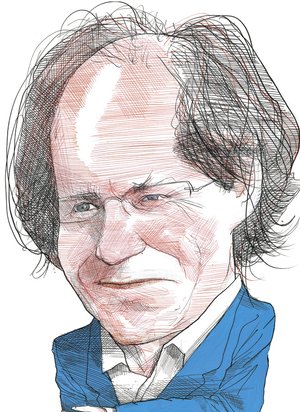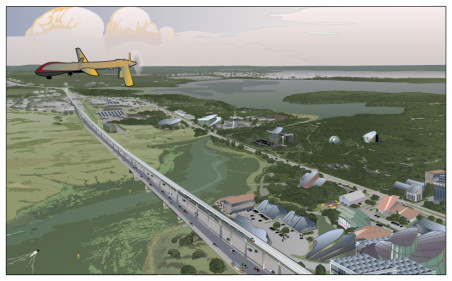
(Professor Cass Sunstein by John Springs in the New York Review of Books).
“What would life in 2070 be like if we collectively shift our values toward community, connections with nature, and sustainable living?”
– Framing statement from the National Science Foundation-funded Yamara 2070 Project at the University of Wisconsin
Well, they got General Shinseki this morning. It is the most amazing thing. Someone was held accountable for something.
That is not true of some of the really interesting people who should be, too. We have talked about Mr. Cass Sunstein before, but in case you blew by it, he is the former administrator of the White House Office of Information and Regulatory Affairs, and is a professor at Harvard Law School and a columnist over that the Bloomberg View.
He has a lot of cool innovative ideas about things that are really good for us. In fact, in order to make our lives better, he has advocated the Government pay people to troll websites and assail clearly wrong-thinking individuals, and active publicly-funded campaigns to “nudge” people in the ‘right’ direction.
If you happen to agree with his point of view, that could be a good thing. If you don’t, well, maybe you might have a little problem with this. Particularly if he is using your money to do the nudging.
He is an interesting man with far ranging thoughts. One of the stranger ideas was the notion that pets should be empowered to sue their owners. Wait, that makes him sound like a loon. I should be more fair. Here is the citation from page 11 of his tome Animal Rights: Current Debates and New Directions: “personhood need not be conferred upon an animal in order to grant it various legal protections against abuse or cruelty.”
There is certainly nothing wrong with that, and I am opposed to abuse or cruelty in just about everything. But Sunstein goes on to suggest that “granting standing to animals, actionable by other parties, could decrease animal cruelty by increasing the likelihood that animal abuse will be punished.”
So it really wouldn’t be Fido suing you, if would be some busybody who took an interest in your relationship with the family dog. Or your cattle. But never mind.
The Professor has all sorts of other interests, too. His latest rumination is about the success the Chinese have with indoctrinating their high school kids. I will let him tell you himself, since I don’t trust myself not to go a little hysterical about his apparent interest in experimenting with that right here in the good ole USA:
http://www.bloombergview.com/articles/2014-05-20/open-brain-insert-ideology
But I have to think about the Professor when I run across some of his style of nudging. You see it all over these days. Remember “The Life of Julia?” that was the cute little PowerPoint presentation that showed how a woman was helped at every crucial juncture of her life by benevolent government programs.
It was a hoot at the time, and thankfully it was campaign donations that financed it. I spent more minutes than I have this morning looking for it, since what remains posted on the web are mostly parodies of the original. Here is a link that works, via the Wayback Machine:
http://web.archive.org/web/20120509061658/http://www.barackobama.com/life-of-julia?source=MeetJulia-02-20120503-signup-HQB&icn=20120503-MeetJulia-02-signup-HQB
Then there was the grotesque parody of American manhood, the Pajama Boy. This was classic nudging, intended to spark conversations about the Affordable Care Act:

It was so distasteful and so mocked that it disappeared almost immediately, but as you know, ‘information operations’ (another term for ‘nudging’) is a complex business, and the show goes on.
I don’t know if you are aware of the Yahara 2070 project. It is a modest waste of cash, given that we have become inured to the billions that Washington shovels out these days on all manner of amazing and magical things. In fact, this bit of nudging was almost a bargain at only $5 million, provided by the National Science Foundation to the Badgers at the University of Wisconsin.

(Helpful Predator UAV patrols the bucolic farmland of the Yahara watershed in 2070 in one of the rosy scenarios after most of the people have been wiped out. Image by John Miller).
Yahara is designed to produce four ‘scenarios’ of how the watershed area around the Wisconsin campus might fare over the next fifty-five years. It is amazing. I mean freaking amazing. Here is one of the quotes about the present day, but set in a bucolic 2070CE after the Great Transformation that I found particularly endearing. It is uttered by a fictional woman named Rosa, who was part of the Badgers for Change Brigade:
“We were discontented with excessive consumerism and angry about the social inequalities and ecological destruction it caused. To us, life quality was not based in quantity, and wealth provided no shield against the crises we were facing. Instead, many of us believed the cultivation of meaningful connections with each other and with nature was more nurturing to our well-being and would enable a more sustainable future.”
Her little granddaughter looks back in wonder, and blurts: “So people back then didn’t think they were connected with nature?”
Trust me, it gets better. Rosa ruminates about how things work in the future after her years of struggle to eliminate property rights, lawnmowers, affordable air fares, the meat and dairy industries and the internal combustion engine:
“For example, you’ve learned in school that the United States Constitution grants explicit rights to nature. The government also pays farmers to help them grow their food organically. These things came from my generation’s prioritization of nature and collective well-being. We believed true happiness came from connection and meaning, and our prosperity relied on our success at nurturing these things.”
In that script I saw Professor Sunstein’s un-calloused hand, and it leads naturally into the rest of the fantasy narrative constructed by a woman named Jennifer Seifert:
“These priorities fueled our desire for sustainability, which means that we can live a good life now, but we must live within the limits that nature has set for us, so that future generations can also live a good life and have their needs met. My generation did a lot to fight for the better social equality and environmental justice….”
You have to love it. The creator of the whole project is named Steve Carpenter, and he praised the four scenarios for being “the edge of plausibility.”
I will give him that, and maybe more. In the most severe of the four scenarios, people fail to prepare for climate change. Agricultural phosphorus pollution releases toxic vapors into the air and 90% of everyone dies.
In a second scenario, heavy federal investment in green tech, biotech and high tech transforms the Yahara watershed into a tech powerhouse. The population doubles.
A third version, the one the quotes above came from, envisions young people invoking a major shift in values toward community, sustainability and lower consumption. Air travel becomes a lot more expensive, as does food. But people also get out of the rat race and have more time to spend with each other. It is like the story about unemployment being good for the economy.
In a fourth future, the nation’s government, responding to a major freshwater shortage induced by climate change, junks state and county lines and reorganizes on watershed boundaries. The Midwest must export water to water-scarce areas, and enacts strict regulations to conserve water.
I don’t know why those are the only futures. I had hoped for one with Godzilla and space aliens, and maybe one where we just sort of muddle along and complain about the weather. But it is really interesting to see our tax dollars at work, and just when you think you have seen about everything, it gets better.
The same National Science Foundation (they are located a short walk from Willow, and it is entirely possible they spend more time there than I do) just awarded a $5.7 million dollar contract to a company that is making “voicemails from the future” possible to listen to right now in the present.
No kidding. There are all sorts of scenarios in this one, too. Paris can only be reached by submarine, that sort of thing. One of my favorites- this one allegedly from 2059, and “decoded” by someone named “Alex” says: “We recommend that you take the new electric Hydrofoil that goes up along the coast, rather than trudging along on the mass transit through the tunnels on land. Take the Hydrofoil. It’s a much nicer view of the coasts. You can see all the new coastal defenses that’s come up to protect the cities and harbors from the rising sea levels.”
I am serious. Only people who think like Professor Sunstein could possibly imagine that this was a useful thing for the Government to sponsor. Take some time and check it out.
It is quite entertaining, like reading Walter Duranty’s accounts of the liquidation of the happy Kulaks in Stalin’s USSR.
And the best part is that we are all paying for it.
Copyright 2070 Vic Socotra
www.vicsocotra.com
Twitter: @jayare303
